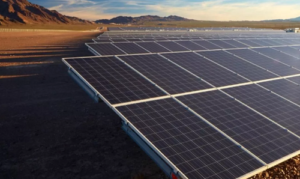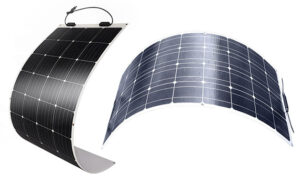The solar cell sheet is a thin semiconductor wafer composed of two different layers of silicon (n-type silicon (blue) and p-type silicon (red)), which are subjected to special treatment or doping. The solar cell sheet is made of the same semiconductor material (usually silicon) used in the microelectronic industry. For solar cells, thin semiconductor wafers are specially processed to form an electric field, with one side being positive and the other side being negative.
A typical solar cell sheet is configured as a large area PN junction made of silicon. The individual solar cells are connected together to form a module (called “solar module” or “PV module”) to increase the current. Meanwhile, in order to further increase the current, the modules are connected into an array (called “solar array” or “PV module”). Solar panels are connected in a variety of ways according to current or voltage requirements.
The lower layer of the solar cell is doped with trivalent elements such as phosphorus, which is called a p-type or positive type layer. The upper layer of the solar cell is doped with pentavalent elements such as boron and aluminum, generating extra electrons. This layer is called an n-type or negative type layer. When light energy irradiates the solar cell, electrons will fall off from atoms in the semiconductor material. If an electrical conductor is connected to the positive electrode and the negative electrode to form a circuit, these electrons can be captured in the form of a current, that is, a current. This power can then be used to power a load, such as a light bulb or a water pump. A typical four inch silicon solar cell generates about one and a half watts of electricity in the bright midday sun. Solar cell is a component of solar panel.
Solar module is a device that converts sunlight directly into electrical energy. Some materials exhibit a characteristic called photoelectric effect. When they absorb photons of light and release electrons, they are captured in the form of current, that is, current. The photovoltaic module is composed of a plurality of solar cells which are electrically connected to each other and installed in a support structure or frame. The assembly is designed to supply power at a specific voltage (typically 12 V). The current generated is directly dependent on the amount of sunlight that illuminates the assembly. Photovoltaic modules have proven to be very durable and reliable. They usually have a service life of 25 years. Although one component is usually enough to meet the power needs of our incubator system or basic solar home system, two or more components can be connected together to form an array. Generally speaking, “the larger the area of a component or array, the more power will be generated”.
Photovoltaic modules and arrays generate direct current (DC) electricity. They may be electrically arranged in series and in parallel to produce any desired voltage and current combination. The solar module provides a charger for the battery through a solar controller, and the inverter is used to convert DC power into AC power for use by household appliances.
If you want to know more about solar panels, please follow us.






